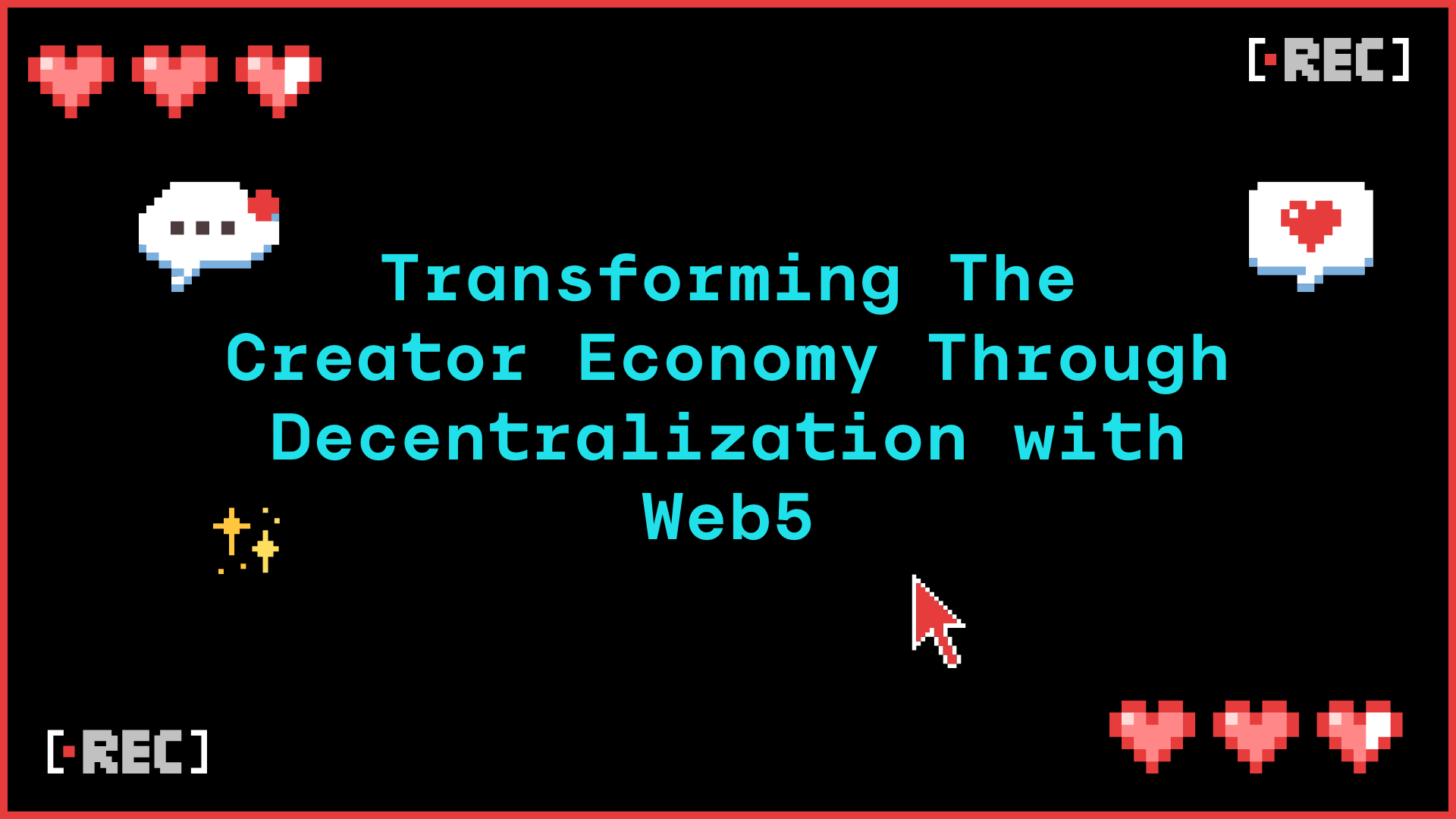Transforming The Creator Economy Through Decentralization with Web5
 Dee Caulcrick
Dee Caulcrick
The creator economy is fast-growing, and individuals worldwide are now empowered to turn their passions and interests into livelihoods, leveraging platforms like YouTube, Instagram, TikTok, and Twitter. Yet, despite its quick growth, this economy faces many challenges, like centralized control, data exploitation, limited revenue avenues, and unfair censorship.
In this article, I will be showing you how Web5, the revolutionary decentralized web platform, can transform the landscape by offering creators unparalleled control over their content, privacy, and revenue streams.
The Challenges
Centralized platforms dominate the creator economy, with each platform having its own strict rules, ever-changing algorithms, and dictating revenue-sharing models. Creators often trade their content and data for access to these platforms, leading to limited control over their content, and subjecting themselves to arbitrary monetization rules and data exploitation.
An example of such centralized control is Instagram, owned by Meta, where users' content and data are subject to platform policies, influencing visibility and monetization opportunities. Dependency on such intermediaries restricts direct interaction between creators and their audience, adversely affecting revenue generation and community building.
Consider a scenario where a creator falls out of favor with the platform policy gods or inadvertently violates censorship rules, risking the loss of their content, audience, or even their username. This sudden loss could obliterate meticulously curated personal brand identities, potentially affecting livelihoods. Imagine losing all your tweets or TikTok videos—hundreds of hours of effort vanished in an instant.
One notable example of this issue is when Twitter took possession of the username @x away from its original owner without notice or compensation when rebranding to X. In such cases, individuals might start from scratch, rebuilding their following from zero.
Currently, online identities and personal data are often at the mercy of third-party apps and services. Despite appearing as owned, usernames or email addresses used across the web remain under the control of these platforms, susceptible to revocation at any moment.
The Potential Solution: Empowering Ownership and Control with Web5
What if this fear were just a nightmare—a scenario impossible to encounter in the real world? What if creators had absolute control over their content and how it is shared? What if ownership of usernames remained impervious to corporate whims (as seen with platforms like X, formerly known as Twitter)? What if, even in contentious situations, creators retained control over their content and audience?
This is where Web5 comes in.
What is Web5?
Web5 is a decentralized web platform that puts you in control of your data and identity.
It's important to note that Web5 isn't a sequential upgrade from Web3. Instead, it represents a harmony between the current web framework, Web2, and the decentralized technology of Web3. In essence, Web2 and Web3 collaborate to birth the concept of Web5.
The TBD website states, “Web5 brings decentralized identity and data storage to your applications, letting devs focus on creating delightful user experiences while returning ownership of data and identity to individuals.”
Decentralized Identity
Web5 introduces a paradigm where creators can manage their online identity through unique identifiers, known as Decentralized Identifiers (DIDs). Unlike traditional centralized systems where social media platforms or service providers manage identities, DIDs put the power in the hands of creators themselves. Through your DID, others can send messages, data, and money (see tbDEX) and gain access to content you want to share. This decentralization removes dependence on intermediaries for identity verification and authentication, offering creators autonomy over their online persona and interactions.
Decentralized Data Storage
Within the creator economy, data ownership and control are pivotal. Web5's approach ensures creators maintain ownership and authority over their valuable content and information. Instead of relying on centralized servers controlled by big corporations or platforms, Web5 empowers creators by storing their data in Decentralized Web Nodes (DWNs). These nodes act as secure storage hubs distributed across a network. This decentralized data storage model ensures enhanced data privacy, robust security, and seamless accessibility for creators, mitigating the risks associated with single-point failures or data exploitation.
How Web5 Changes The Game and Empowers Creators
Enhanced Control: Creators have complete control over what they create and own. Rules set by big platforms do not limit them, and their data is safe from being used without permission.
Privacy and Trust: Creators and their audience can trust that their information is secure and won’t be seen by anyone they don’t want. It’s like having a secret message code, so only the right people can read them.
Direct Monetization: Creators can get money directly from fans without intermediaries taking a cut. With decentralized payment channels, creators engage directly with fans, reducing intermediary fees and exploring new revenue streams.
Direct Access to your Audience/Community: Within a Decentralized Web App (DWA) built on Web5, no intermediaries are between you and your audience. This eliminates concerns about losing your audience or struggling to outperform algorithms to deliver your content directly to your audience.
Conclusion
Although Web5 is still under development and is constantly being improved, it represents a radical transformation in the creator economy—placing control, privacy, and revenue back into the hands of creators. By embracing decentralization, creators wield newfound power—ownership and transparency—paving the way for an equitable, transparent, and empowering creator economy.
The future calls for a creator-centric ecosystem driven by decentralization, reshaping the very fabric of the creator economy—a landscape where creators thrive, communities engage, and innovation knows no bounds.
To learn more about Web5, check out the TBD developer documentation or read their blog.
Subscribe to my newsletter
Read articles from Dee Caulcrick directly inside your inbox. Subscribe to the newsletter, and don't miss out.
Written by

Dee Caulcrick
Dee Caulcrick
Hi, I'm Dee, a computer science student who loves to explore and teach web technologies.